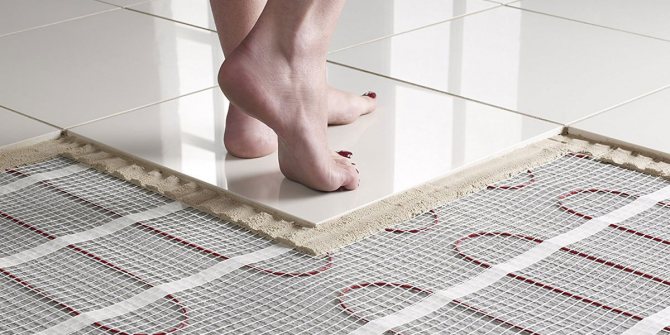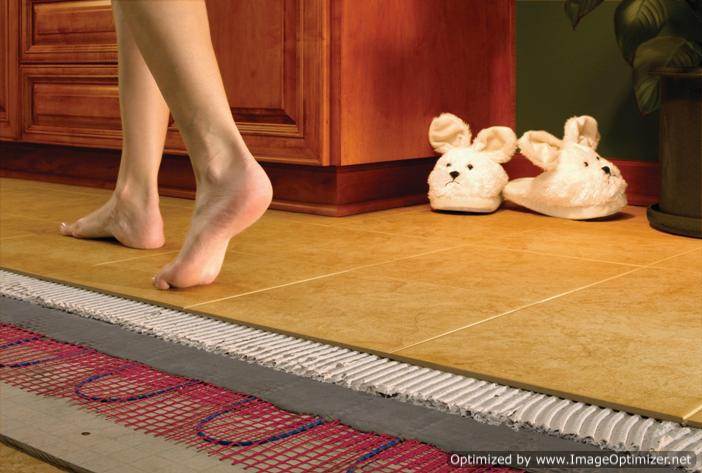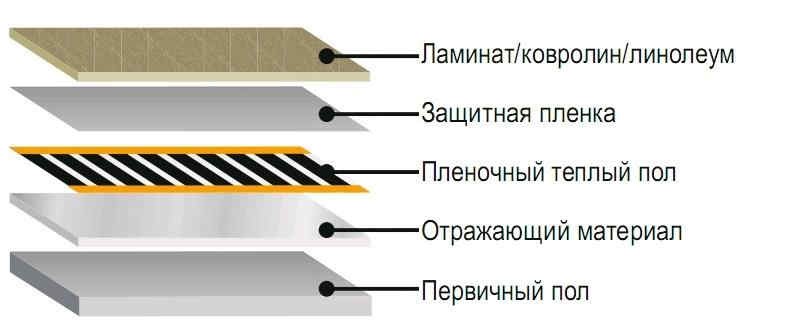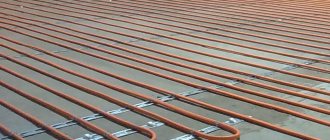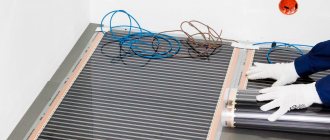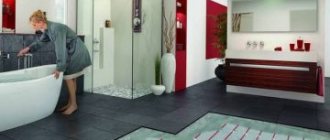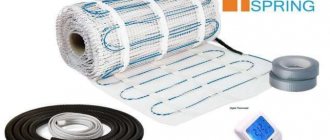The craze for environmental friendliness, as well as the slight paranoia that people experience in front of everything new, gave rise to many legends about the dangers of warm floors. Articles and TV programs are full of sensational exposing materials in which "scientists have convincingly proved" this or that fact. However, sometimes there is more emotion in the evidence than numbers. Let's try to find out if a warm floor is actually harmful to health by looking at the problem from the point of view of current standards and sanitary standards.
What is really worth paying attention to?
In this article, we deliberately omit the issues of comfort and temperature distribution in rooms heated with underfloor heating (TP). Often the answer to them depends on subjective feelings. The question of the compatibility of heated surfaces with various types of floor coverings is also left out. The release of carcinogenic substances from facing materials, their temperature deformations and other negative factors are reduced to permissible values if the instructions of the manufacturers of construction and finishing products are strictly followed. For example, if you use: heat-resistant tile adhesive, laminate or linoleum, the markings of which indicate the admissibility of use in floor heating systems, then all the problems listed above are removed by themselves.
However, there are really serious moments that require the closest attention:
- permissible level of influence of electromagnetic radiation;
- permissible level of influence of infrared radiation;
- electrical safety;
- Fire safety.
In this regard, we will consider how safe it is to install water and electric floor heating systems in residential premises.
Surface ceramic floor coating is harmful
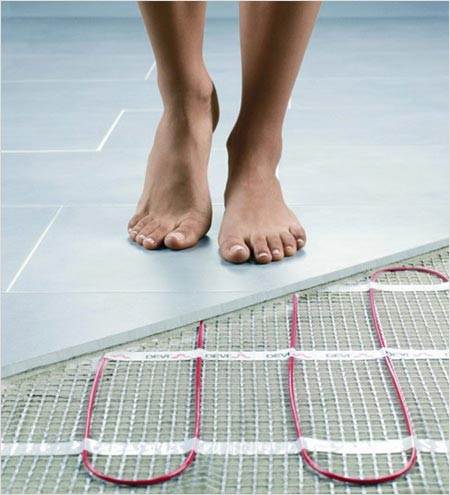
The pros and cons of the tile covering in the underfloor heating system are that the tile is characterized by a high value of heat capacity. Therefore, heat dissipation and radiation have a slow but constant effect. This suggests that it will take a long time to warm up the room, but the effect after shutdown lasts longer. At the same time, there is no vapor barrier film, which contributes to an increase in the thermal efficiency of this heating principle. In rooms such as the kitchen, where the increased temperature background is almost constant, such heating systems are harmful. Especially for women who spend a lot of time in the kitchen. The harm is caused by the constant exposure to elevated temperatures on the legs, which causes blood to flow upward. As a result, thermal radiation provokes the emergence and development of some gynecological and vascular diseases. Harm to the body from such systems can threaten with the frequent stay of the feet on such a coating for more than 3 - 4 hours. But with a short stay on such a floor, there is no danger to health, therefore, the installation of a warm floor system under a tiled floor, for example, in bathrooms, is quite safe.
Water heated floor
The greatest harm to a water heated floor is a critical local increase in the temperature of the floor covering up to 30-40 ° C. Here we are already talking not about comfort, but about the inadmissibility of using such a system. In most cases, the reason lies in gross errors in the design of the thermal installation. For example, a water heat exchanger can be used as the main source of heating in a room with a large area, and its external thermostatic regulator (with an automatic detector) can be located too far from the heated surface. Such a system will have a high temperature inertia. After all, the air in the room warms up slowly, while individual areas of the coating are already warming up to critical values.
Such constant extreme operation at high boundary temperatures significantly reduces the service life of pipelines, which threatens to violate their integrity, leakage and flooding of the premises from below. In addition, an improperly installed underfloor heating water floor can sometimes cause condensation (especially in the corners of external walls). Condensation, as well as sharp temperature fluctuations, can harm household appliances, in which electrical contacts are oxidized.
Important! With proper installation and operation, there is virtually no harm from a warm floor to the health of people who do not suffer from chronic diseases. Therefore, such a heating system for housing for humans and pets is the safest.
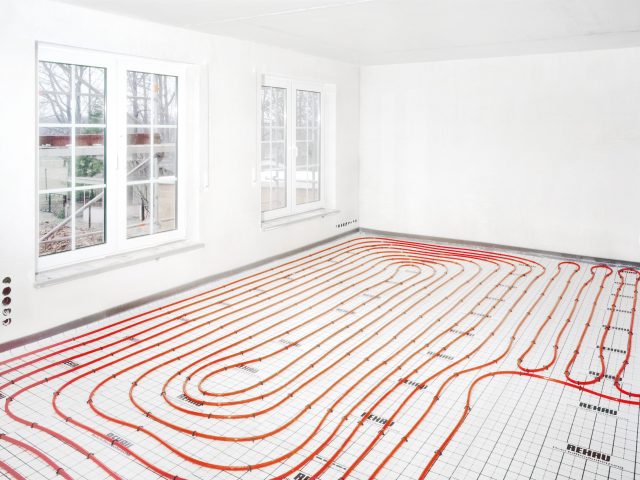

Underfloor heating is harmful if used incorrectly and improperly installed
It is believed that such heating is available for installation to almost everyone. However, this is not the case: only a qualified specialist will be able to correctly install and start the “warm floor” system, otherwise, defects and installation errors turn into significant financial costs. However, the very system of such heating is considered thought out to the smallest detail.
However, there are situations when an illiterately installed heating subsequently causes noticeable harm to homeowners:
- As a topcoat, a material was used whose performance characteristics do not provide for constant heating. For example, parquet is overdried by constant contact with a heated surface. This not only reduces the durability of the coating, but also reduces the relative humidity in the room. This negatively affects the health of children, allergy sufferers and asthmatics, since their body requires an optimal level of humidity;
- During installation we decided to “save money” on thermostats. The result - in the dry air, a lot of fine dust is formed, which can also cause great harm, especially for people prone to allergies;
- With improperly equipped ventilation, the underfloor heating system provokes the formation of fungi and mold, and also causes fogging of the windows. In this case, thermal radiation brings undoubted harm, since it is fraught with possible skin diseases and damage to household property.
If we sum up all the pros and cons, then the conclusion will be unambiguous: the underfloor heating system does not pose a threat to the human body. The main thing is to strictly adhere to the manufacturer's recommendations, and then the heating of the house will be efficient, safe and reliable.
Electric underfloor heating
There are the following most common types of electrical transformer substations - cable (single-core, two-core) and infrared (IR) film. Electric heating devices in the form of thin mesh mats are nothing more than a more technological type of heating cables. Like all conductors, with a current flowing in them, they propagate an electromagnetic field around them, the measurement of which is carried out in units of magnetic field induction and is expressed in Tesla (T or T) and microteslas (μT or μT).
Influence of electromagnetic radiation on humans
The epidemiological survey carried out by the sanitary service of the Russian Federation "Survey of the population permanently living in conditions of exposure to electromagnetic fields of power lines" made it possible to determine the value of the safe intensity of these fields. Thus, it was found that the value of the flux density of magnetic induction under long-term exposure that does not lead to negative consequences (oncological and other diseases) is 0.2-0.3 μT. For example, let's give the flux density of magnetic induction generated by some household electrical appliances:
| Type of bit electrical appliance | Max μT | Min μT |
| Iron | 0,1 | 0,4 |
| Vacuum cleaner | 0,2 | 2,2 |
| Television | 0,1 | 2,0 |
| Washer | 0,1 | 2 |
| Microwave | 4,0 | 12 |
| Electric stove | 0,4 | 4,5 |
| Drill | 2,2 | 5,4 |
| Underfloor heating cable single-core | 2 | 3 |
| Underfloor heating cable two-core (shielded) | 0,2 | 0,5 |
As can be seen from the table, a two-core shielded cable for underfloor heating almost completely meets the requirements of sanitary standards for the flux of electromagnetic induction.
Although the average level of the flux density of magnetic induction for the planet Earth is 50 μT, it belongs to the natural background, therefore it does not have a negative effect on healthy organisms.
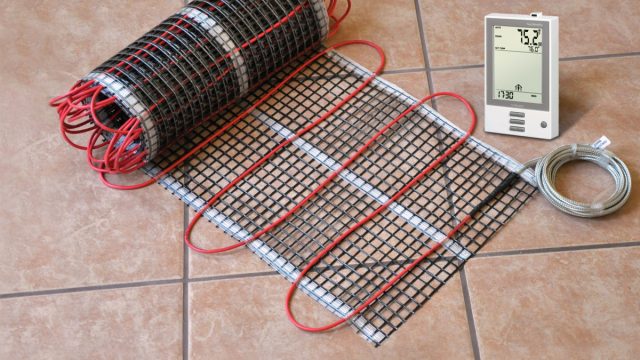

How to choose a cable TP and protect yourself as much as possible?
- When buying a specific model of a cable product, in order to minimize the harm of a heated floor, you should pay attention to the environmental safety standard. Solid products must have a certificate of compliance with the ISO 14000 standard.
- It is recommended to give preference to a two-core shielded cable. That is, it must have not only reliable electrical insulation, but also a shielding metal braid that completely extinguishes radiation, and also performs the function of grounding.
- Electromagnetic radiation can have a significant impact on health only in the case of a prolonged stay in the zone of its greatest intensity. Therefore, if you are concerned that cable floor heating is unhealthy, then it is better to lay it in those parts of the premises that are not areas of rest or frequent stay of people.
Oops! When buying a cable TP, you should seriously consider reliable manufacturers under brand names. This will provide an essential guarantee of maximum compliance of the product with sanitary and building codes.
Infrared radiation effects on living organisms
As well as for electromagnetic radiation, there are sanitary standards for infrared. They are spelled out in the hygienic requirements of SanPiN 2.2.4.548-96. The table shows some indicators of the permissible radiation intensity of the IR source, in W / m2:
| The naked area of the human body (%), which is exposed to radiation | Wavelength, μm | |||
| 1,5 | 3,0 | 4,5 | 6,0 | |
| no more than 40 | 30 | 55 | 70 | 55 |
| no more than 20 | 60 | 105 | 135 | 105 |
These standards are valid for a long stay of a person in a room with an active infrared heating source.
However, in reality, the IR spectrum is much wider. It occupies the range λ = 0.74 microns ... λ≈ 1-2 mm, which, according to the degree of impact on the human body, is divided into three parts:
- IR-A (0.76-1.5 microns) - maximum deep penetration into the subcutaneous layers and skin (up to 4 cm). Used in heaters that are used for infrared saunas;
- IR-B (1.5-3 microns) - penetration under the upper layers of the epidermis to a depth of 0.5 cm;
- IR-C (> 3 μm) - radiation is completely absorbed by human skin. The maximum penetration does not exceed 0.2 mm.
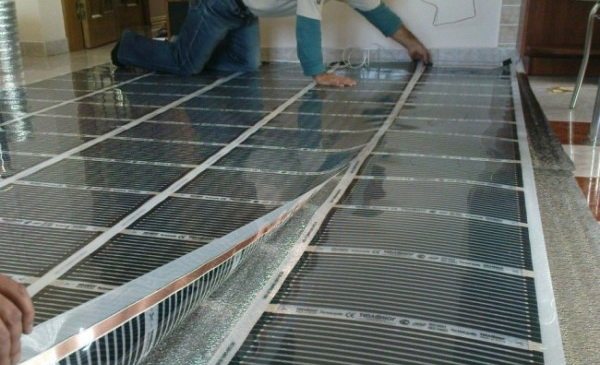

How do you choose the “right” IR film?
All three ranges are present in the waves emitted by the infrared film. But the predominance of some energies over others changes during the functioning of the IC TP. As the temperature rises, the radiation spectrum goes over to the short-wavelength range, and upon cooling, into the long-wavelength range.
What is the safest wave size for the human body? At a normal body temperature of a healthy person, 36.6 ° C, the peak of infrared radiation falls on a wavelength of 9.6 microns. Thermal energy, close to this value, has a neutral effect on the body and is perceived by us as the most comfortable.
Many manufacturers of infrared emitters from China as advertising declare the wavelength of 9.6 microns as the main working one. At the same time, pointing out how a warm floor affects health, they emphasize that the body will be warmed up to a depth of 4 cm.In fact, waves of this length refer to the IR-C standard, according to which only surface heating of the body occurs, without penetration under skin.
Important! When purchasing an infrared film TP, you should pay attention to its specification. If the manufacturer indicated in it not one value of the IR wave, but the operating range, then he and his products are trustworthy. For most products, the boundary frames of the prevailing wavelengths are in the range of 3-10 microns.
Is the system harmful?
If you study the question of whether an electric underfloor heating has harm to human health, then you can find defects in such heating systems. For example, a cable floor can emit electromagnetic waves, but tests have shown that they are no stronger than, say, in a microwave or TV. It is unlikely that a person surrounded by numerous electrical appliances and mobile phones will feel this radiation at all.
Another question is how effective underfloor heating is as the main source of heat, but this is a completely solvable task. It is enough to insulate the room so that electric floors not only heat well, but also become economical.
Doctors very rarely indicate unequivocally that any influences of the modern world are harmful. We need statistics, expensive research ... Regarding the warm floor, there are also no exact conclusions of the Academy of Sciences ... But "alarming rumors" and "suspicious speculations" did not arise out of nowhere. Let's figure out what is known exactly in fact about this, and also consider the generalized opinion of experts about the dangers of warm floors, and the typical actions of typical "conscientious" installers, under the slogan "do no harm."
Tell me doctor ...
Any therapist, or at least every second sober one, will say that if you keep your legs constantly in a basin of lukewarm water, then something unhealthy will definitely happen to them - “veins will swell, joints will swell”. You can go to the nearest clinic and terrorize the doctor on duty in this regard.
It has been pointed out more than once that unnatural heating of the lower extremities leads to increased blood flow and vascular diseases.
It remains to find out what is "unnatural" and what temperature of the heated floor will be dangerous, and what - acceptable.
From the available information, it is only known that if the floor temperature is +28 and higher, then it will seem warm, since this is the temperature of the human skin surface. And, by the way, being in such an environment for a long time, people begin to experience discomfort.
Hence the unequivocal conclusions of experts - keep a comfortable temperature of the heated floor covering, more often in the region of +18 - +24 degrees. The coating should feel "cool", then it will suit everyone, and no complaints about it yet ...
The floor is electric
Electric floor heating has electromagnetic radiation. This radiation has not yet been called useful. With an increased background of eggs, chickens do not hatch, etc.
They say that the field strength from such systems is not great, but this is not true. The fields are summed up, from sockets, floors, wires outside the window, refrigerator ...
It is impossible to equip this in a nursery, children should not be on a surface emitting an increased electromagnetic background.
Special danger of underfloor heating
They say very little about the real danger that the warm floor conceals, so it is not superfluous to recall here.
We, as a rule, do not have separate ventilation in the rooms. For the winter, windows can be battened down tightly.
With a radiator heating system, a powerful convection air flow occurs. It also entails the movement and mixing of air through the doorway, so that there is a fairly intense air exchange between rooms. And thus, even a sealed room is ventilated at the expense of those adjacent to it.
With only one warm floor, there is no convection. There is no air movement. In a room without ventilation devices, without gaps in the external structures, there will be practically no air exchange.
If there is no walking through the doorway, air stratification may occur - carbon dioxide is heavier, will begin to accumulate near the floor, and so-called "dead air" will appear. If there is a release of carbon dioxide or other harmful gases in the room itself, then this is already very dangerous ...
Fire and electrical safety
In this category, the best performance is shown by a water-heated floor. On the contrary, electric heating systems (with the exception of self-regulating ones) can overheat and fail due to installation errors or subsequent incorrect operation. For example, when the thermoelement is placed shallowly relative to the floor covering densely packed with furniture. Careless installation also results in the risk of a short circuit and fire in the thermal electrical installation.
With regard to the danger of electric shock, harm from a warm floor looks rather unlikely. After all, all certified systems have high-quality insulation. It reliably protects the internal wires from moisture penetration, therefore, the probability of electric shock is practically zero. For example, both cable and film underfloor heating are sometimes used for installation on the streets (for gazebo floors, sidewalk paths in backyards, for heating greenhouses, etc.) or in damp rooms. Of course, in such extreme conditions, they resort to enhanced protective measures, but such a possibility is allowed.
In order to practically eliminate the risks of harm to health or damage to property by a warm floor, it is necessary to adhere to the standard conditions for the safe conduct of electrical work and the subsequent operation of electrical equipment. They are detailed in the PUE - electrical installation rules. The connection of the electrical transformer substation, regardless of its type, should be carried out directly from the input switchboard through separate thermal and current protection machines. In the event of short circuits or conductor insulation faults, these devices will instantly de-energize the electric floor heating system.


When there can be problems
The only condition when problems with underfloor heating may arise is the wrong choice of the system and its installation with errors. When choosing one or another type of heating device, for example, an electric heating mat or a pipe system with a coolant, it is necessary to strictly follow the technical regulations and take into account the parameters of the room.
There are several types of mistakes that installers make during the installation of a warm floor, these include:
- When installing a water floor, if you place the collector below the main line, the system will constantly be filled with air, as it tends to the highest point. This factor can completely clog the pipe, which will disrupt the circulation of the coolant. To avoid such consequences, it is necessary to position the manifold in the highest position and equip it with an automatic air vent.
- The most common mistake in cable floor heating is damage to the outer winding of the heating element or a broken core in an unnatural position. Also, the supply of a high voltage current that does not correspond to the thermostat rating leads to a burnout of the harness. For smooth operation, it is necessary to equip the electric underfloor heating system with a voltage stabilizer that will prevent current surges by leveling it.
- Film underfloor heating with infrared radiation, the most vulnerable at a break, for example, when pouring it into a screed, when copper conductors are under the pressure of the mixture, bending or deformation of even one thread will lead to loss of contact and complete failure of the system. In order to prevent this breakdown, it is necessary to carefully choose the building mixture for the floor screed, it is desirable that it be a powder with a fine fraction.
findings
From the presented facts, it becomes obvious that water TP is the safest for humans and pets. This is followed by a two-wire shielded cable electrical TP. Due to the effect on living organisms of the magnetic flux and a wide spectrum of infrared radiation, infrared warm floors are harmful to health a little more. Despite their minimal cost, single-core unshielded heating cables are the least desirable for installation in rooms with constant presence of people.
https://www.youtube.com/watch?v=mESjsvnlgzA
Infrared floors and engineering systems
Only professionals are interested in this issue, consumers do not consider it necessary to delve into the topic. And in vain, the safety of the entire building depends on the knowledge of the influence of the infrared floor on engineering systems.
What should consumers pay attention to?
1. Maximum power of electrical networks in an apartment or house. Standard apartments are designed to consume no more than 4 kW of power for all household appliances. Taking this indicator into account, the cross-section of current-carrying cables, technical indicators of protective equipment, etc. are calculated. Of course, electricians during installation give a certain margin, but how much and whether or not nobody knows. In order to have a tangible effect from the use of an infrared floor as a heating system, a power per square meter of at least 200 W / m2 is needed. And this is with perfect thermal insulation of floor ceilings and facade walls. If the apartment is 100 m2, then only the infrared floor will require 20 kW of free power. Now compare the four planned and twenty required kilowatts. There is a difference? Way out - before installing the infrared floor, you should completely redo the electrical wiring of the house and obtain permission from the owner of electrical networks to increase the power. The owner of the networks does not always give such permission, in most cases he does not have free capacities. The reasons for this situation are different, but the main one is the unwillingness to invest profits in the development of infrastructure.
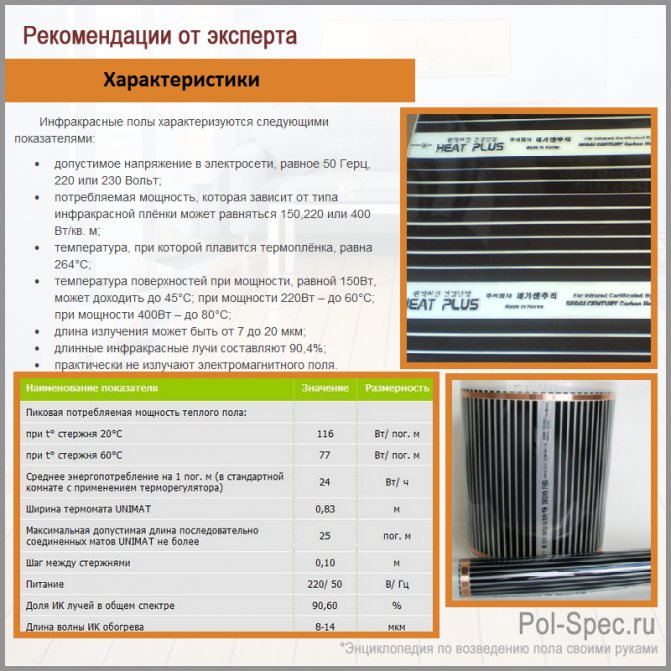

Characteristics
2. Operational safety. The infrared floor is connected to a voltage of 220 V. The installation technology provides for several stages of equipment protection, but do the installers always strictly follow the instructions recommended by the manufacturer? Violations of the PUE, unfortunately, are not so rare. And during operation, various unforeseen situations may arise. To measure, flooding of the flooring due to a breakthrough in the water supply system. In science there is such a concept: if the probability of an event is not zero, then it must always be taken into account. This means that electric shock to users is possible.
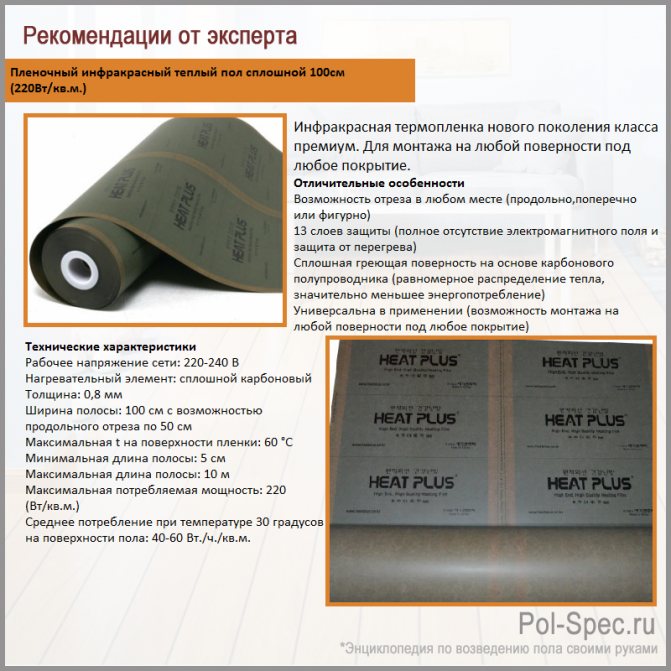

Film infrared warm floor continuous 100cm (220W / sq.m.)
Experienced builders strongly recommend providing for the use of infrared floors for heating even during the design work and approval of documentation in all supervising state organizations and owners of engineering networks.
A few words about the benefits. This is the only type of heating, the technology of arrangement of which does not provide for the use of "wet" materials, which allows to significantly expand the scope of use of infrared floors, to significantly reduce the installation time.

